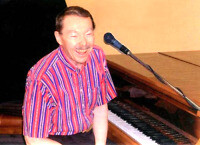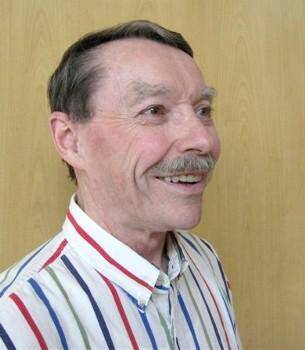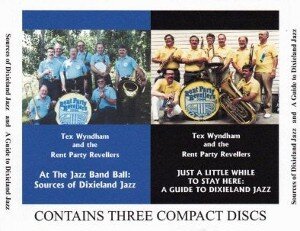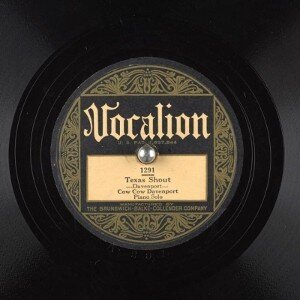 Set forth below is the thirty-fourth “Texas Shout” column. The initial installment of a two-part essay, it first appeared in the November 1992 issue of The West Coast Rag, now The Syncopated Times.
Set forth below is the thirty-fourth “Texas Shout” column. The initial installment of a two-part essay, it first appeared in the November 1992 issue of The West Coast Rag, now The Syncopated Times.
Because the text has not been updated, I should mention that, since this essay first appeared, Wally Rose, and other musicians who recorded with Watters and the Yerba Buena Jazz Band at one time or another, have gone to their reward. Their names will be fondly remembered as long as Dixieland jazz is played.
Through the years, there have been many enormously influential Dixieland bands. However, only one combo has ever singlehandedly created a new style of Dixieland. The band is Lu Watters’ Yerba Buena Jazz Band and the style is called West Coast revival (sometimes known as San Francisco style).
I’d like to use today’s column to discuss the characteristics of the West Coast revival style. Along the way, I’ll toss in some thoughts regarding what I believe to be misconceptions about it in certain areas of the Dixieland community.
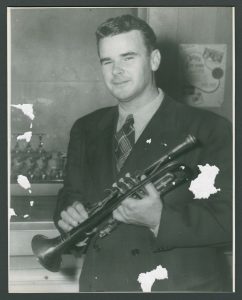
Trumpeter Watters and his sidemen were professional musicians making a living playing the prevailing popular and jazz styles of the late 1930s, essentially swing and big-band dance. At the time, the most common form of Dixieland was Chicago style, the Dixieland style that best fits the solo orientation of swing musicians.
Watters and his colleagues had been listening to small-band recordings of the 1920s, particularly the downtown New Orleans style 78s of King Oliver, Jelly Roll Morton and Louis Armstrong. Hearing an approach to the music that was hardly to be found anymore; an instrumentation employing two-beat rhythm, banjo and tuba, all musical devices not employed by swing musicians; and some worthwhile tunes that had been totally forgotten, they decided to get together after hours to revive this instrumentation and repertoire.
After some jam sessions at the Bay Area’s Big Bear Tavern, the band went into the studio on December 19, 1941 to wax eight sides which were released on the Jazz Man label. The lineup was Lu Watters, Bob Scobey, cornets; Ellis Horne, clarinet; Turk Murphy, trombone; Wally Rose, piano; Clancy Hayes, Russ Bennett, banjos; Dick Lammi, tuba; and Bill Dart, drums.
The YBJB’s sound resembled nothing previously heard on the Dixieland scene. It touched off a storm of controversy between the band’s supporters and detractors involving, in my view, a degree of misunderstanding on both sides that continues down to the present day.
Life is often a series of trade-offs. One gives up something in order to get more of something else.
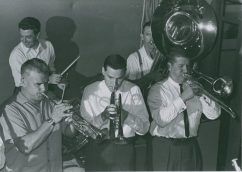
Up until the YBJB’s recordings, jazzmen had chosen to go for as much buoyancy as possible, to get the sound “off the ground,” to achieve the springy effect that was considered to epitomize “swinging.” In order to do so, one must typically give up a measure of volume, a tradeoff which also involves some relaxation of punch. Said another way, few instrumentalists are able to maintain a feeling of buoyancy, of floating on the beat, while simultaneously playing loudly and with lots of muscle.
The Yerba Buena Jazz Band, judged by the music it produced, made (consciously or not) the opposite choice. It elected to go for power, and to give up both dynamics and buoyancy to get the maximum amount of power.
Thus, the most easily identifiable characteristic of West Coast revival is its brassy, full-throated, forceful ensemble sound. It comes at you like a steamroller. Instead of inviting you to lift your feet and soar over the dance floor, it demands that you strut across it in much the same way that a military band stirs you to “second line” by marching nearby down the sidewalk.
The YBJB’s ensemble was totally devoid of dynamics. It played at top volume all the time, on every recording Watters ever made, generating about the loudest sound ever heard from a jazz band of its size – an aggressive, outgoing, pile-driving sound that grabs you by the shirt front and drags you along with it.
Its rhythm, instead of following the prevailing trend toward lightness, was the heavyweight champion of jazz. Lammi’s groaning tuba came down on the beat like a ton of bricks, the two banjos and Dart’s metronomic woodblocks set up a beat that would penetrate the tinnest ear, and Rose’s two-fisted piano kept going throughout the sides, rolling up and down the keyboard behind both solos and ensembles.
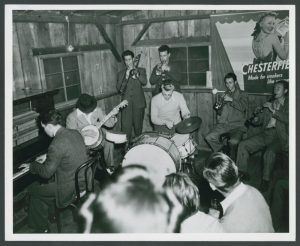
The jazz world hardly knew what to make of the YBJB. Pianists of the thirties had followed Earl Hines’ lead toward spare, single-note treble lines, spiced by left-hand jabs, letting the bass, drums and (if there was a stringed instrument) guitar deliver the expressed beat formerly handled by the left hand – all while staying out of the soloists’ way. Drummers had been moving away from the steady, booming bass drum, heading for the lighter sounds on their kits – the snare, the ride cymbal, the closed hi-hat, the brushes. Softer-edged instruments, such as string bass and guitar, were typical, setting up less likelihood of clashing with the relatively dense lines employed by swing soloists vs. the preceding generation of Dixielanders. The Yerba Buenans turned their backs on all of these developments.
Not surprisingly, many members of the jazz community did not respond well to such rejection of their values. It was commonly asserted, and still is in some places, that Watters had set jazz back twenty years and that his music did not swing. Actually, neither accusation is justified.
Although the YBJB’s rhythmic feeling has more in common with a brass band than a 1930s swing band, it clearly swings. The YBJB has a wonderful cohesion, and all of its sidemen play with a jazz feeling. Compare the Yerba Buena Jazz Band with, for example, a circus band or a military band, and you will recognize right away that the YBJB is indeed playing jazz, that it generates a heat and drive that these other, somewhat similar units lack.
As for setting jazz back in time, quite the reverse is true. The YBJB’s sound was so new and different that it inspired disciples who maintained its approach as a separate Dixieland style.
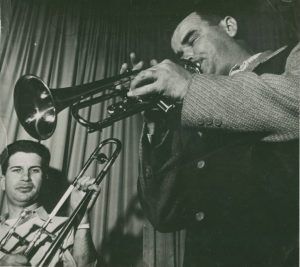
I have occasionally seen it said that Watters was trying to imitate King Oliver’s Creole Jazz Band. Perhaps the surviving members of the YBJB can say definitively whether such was the case, but based on what I hear on the records, I can’t go along with that statement.
Watters may have gotten the idea for a two-trumpet front line from hearing Oliver’s discs, but even a casual listener comparing the records should be able to recognize within the first few bars that the Yerba Buena Jazz Band sounds nothing at all like the Creole Jazz Band. Watters and his men, as I’ve said, were accomplished professional musicians who were perfectly capable of recreating the twenties recordings note-for-note, with the proper timbre and inflections, if they wanted to do so. If they had been trying to imitate Oliver or any other 1920s jazzman, it’s hard for me to believe that they would have missed this goal so completely.
What Watters did was what all good jazzmen should do. He got under the skin of the music, came to understand it fully, and played it his way. He found a way to make a distinctive and personal statement within the basic Dixieland framework.
Indeed, it was because the YBJB didn’t sound like any other band that it was able to create a new Dixieland style. If it had sounded like the Creole Jazz Band, or the Hot Five, or the Red Hot Peppers, I doubt that anyone would have remembered Watters for long. Offhand, I can’t think of any jazzman who’s attained a truly lasting reputation by imitating some other jazzman.
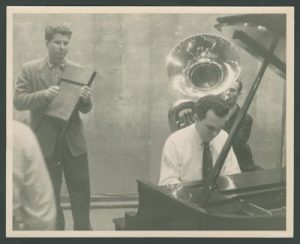
Because most critics know that it was Watters who brought the banjo and tuba back to Dixieland, it seems to me that many of them are too quick to conclude that any banjo-tuba Dixieland band is automatically a West Coast revival unit. Such a conclusion ignores the fact that, prior to the wide adoption of electrical recording around 1925, just about all jazz bands with string and bass instruments utilized tuba and banjo, which better fitted the older acoustic recording techniques than guitar and string bass.
There were already five Dixieland styles up and running before the YBJB came along – white New Orleans, hot dance, uptown New Orleans, Chicago, and downtown New Orleans. All of these recorded with banjo and tuba on occasion. The presence of a tuba and banjo does not necessarily mean that a band is a West Coast revival band; regardless of its instrumentation, and regardless of whether it plays with a two-beat or four-beat pulse, a combo has to generate that feeling of going for substantial power to be a post-Watters unit.
What are the other distinguishing characteristics of West Coast revival? The striving for power is the easiest one to hear, but there are a few others. They all result from the fact that the style itself traces back to one small group of specific musicians, i.e., the customary way of playing a given instrument in West Coast revival style depends in large part on the way a specific Yerba Buenan executed his assignment.
For example, as noted above, the pianist tends to have a decided streak of ragtime in his playing, and to play in a strong two-handed way throughout the performance, just as Wally Rose did. I cut my jazz piano teeth on Rose’s playing as recorded with Watters and Murphy. I didn’t fully realize how different this approach was, opposite some other Dixieland styles, until the time years ago when I was hired for a gig with a band that proved to be a Chicago-style band; I played so many notes that I just about drove the clarinetist crazy (the leader and I got things straightened out at the first break).
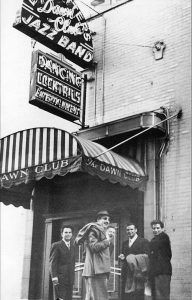
Similarly, the West Coast revival style has an outgoing spirit tempered by only a moderate blues content. Some of this blues element came from Bob Scobey, whose distinctive, incisive trumpet reflected a blend of Armstrong and the straight-ahead Chicago lead tradition. Most of the blues feeling, however, came from the two Yerba Buenans who had the largest degree of blues in their sounds – trombonist Turk Murphy, whose rasping timbre and sure-footed counterlines showed the attention he’d paid to lowdown sliphornists like Roy Palmer and Kid Ory, and clarinetist Bob Helm (not on the initial YBJB session, but the definitive YBJB stickman), whose thick, slurry lines were about the only ones in the 1940s electing to follow Johnny Dodds’ path (while everyone else was trying in vain to catch Goodman).
Despite all the controversy, Watters lived to have the last laugh. He saw the West Coast revival style spread throughout the world, as bands from Europe to Japan unabashedly generate the YBJB’s sound.
Further, Watters saw how common his style became on the U.S. festival scene. Take a typical lineup for a Dixieland festival that hires organized bands. Subtract out the names that don’t really play Dixieland – the big swing bands, the ragtime orchestras, the country units, the blues bands, the pop orchestras, the Latin combos, etc. If you sort the remaining Dixieland outfits into the seven Dixieland styles, I’ll bet that, at many festivals, you’ll find more these days in the West Coast revival category than any other.
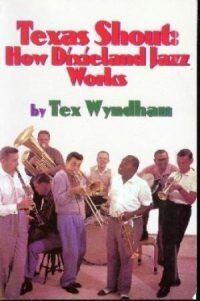
The full run of “Texas Shout” has been collected into a lavishly illustrated trade paperback entitled Texas Shout: How Dixieland Jazz Works. This book is available @ $20.00 plus $2.95 shipping from Tex Wyndham, On request, Tex will autograph the book and add a personalized note (be sure to tell him to whom the note should be addressed).
Tex Wyndham’s 3 CD Guide to Dixieland with music and commentary is available for $20 plus $2.95 shipping. The separate CD, A History of Ragtime: Tex Wyndham Live At Santa Rosa, is available for $13.00 plus $2.00 shipping. On request, Tex will autograph the inner sleeve and add a personalized note (be sure to tell him to whom the note should be addressed).
Send payment to Tex Wyndham, P.O. Box 831, Mendenhall, PA 19357, Phone (610) 388-6330.
Note: All links, pictures, videos or graphics accompanying the Shouts were added at the discretion of the Syncopated Times editorial staff. They did not accompany the original columns and do not necessarily reflect the opinion of Tex Wyndham.
From roughly 1970-2010, Tex Wyndham was: (1) one of the best-known revivalist Dixieland jazz musicians in the US, as cornetist, pianist and bandleader, (2) one of the best-known ragtime pianists in the US, and (3) one of the most respected critics in the US of Dixieland jazz, ragtime, and related music. He is the only person about whom all three of those statements can be made.



